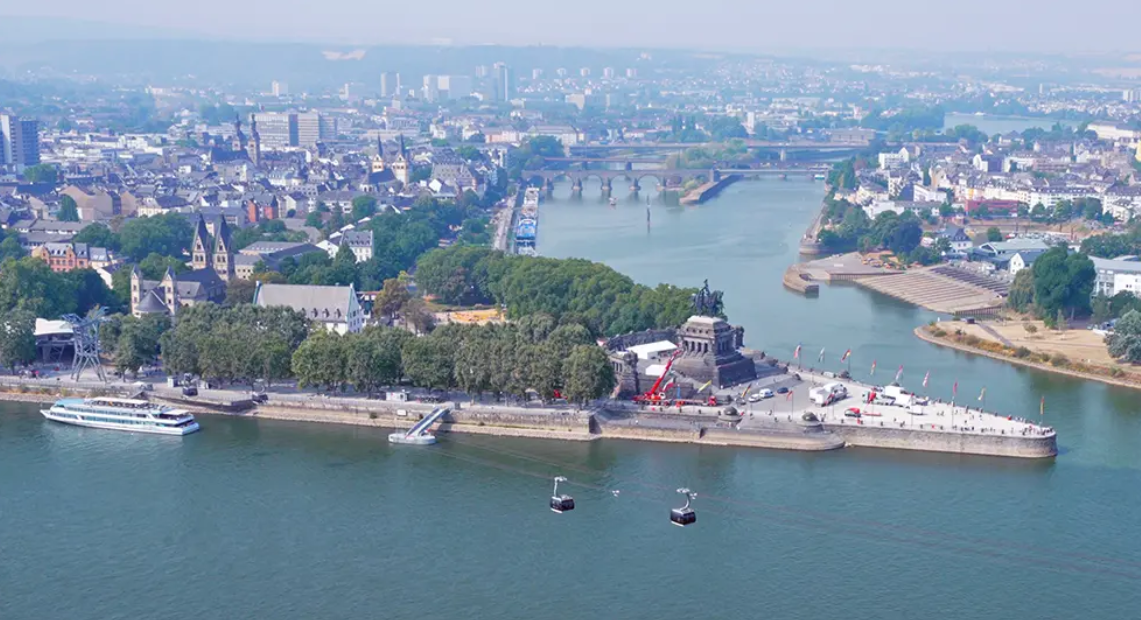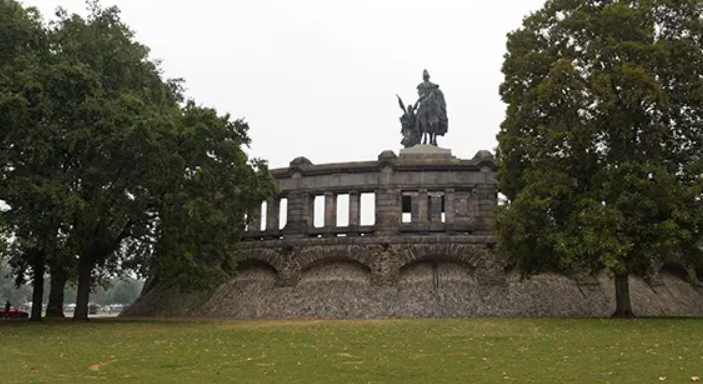Artificially created headland in Koblenz where the Moselle River flows into the Rhine
Address: Deutsches Eck, Konrad-Adenauer-Ufer, 56068 Koblenz | Built: 1895 to 1897 | Height: 37 m
The Deutsches Eck in Koblenz is nestled in a striking landscape where the Moselle River meets the Rhine. The Deutsches Eck takes its name from a nearby settlement of the Teutonic Order. Today, the artificial headland is best known for its monumental equestrian statue. The monument honors Kaiser Wilhelm I, erected shortly after his death to commemorate his achievement in bringing about German unification after three wars. It was erected in 1897 and is a likeness of Kaiser Wilhelm I. Mounted on horseback, he gazes proudly into the distance in his smart uniform. There’s much more to discover and marvel at at the Deutsches Eck. A magnificent view is also provided.
Directions and location of Koblenz’s landmark
Those who visit the Deutsches Eck are entering historic territory steeped in history. And there’s plenty to discover if you take a closer look. The Deutsches Eck is impressively located at the point where the Rhine meets the Moselle in Koblenz. On the artificially created peninsula, there are the Peter Altmeier Ufer on one side and the Konrad Adenauer Ufer on the other. The Deutsches Eck can be reached via Danziger Freiheit and Ester Bejarano Street. The Deutsches Eck can also be reached by the Liesel passenger ferry across the Moselle. The pier is located
Opening Hours and Tours
The Deutsches Eck is a public area open 24 hours a day and can therefore be visited at any time.

Entrance Fees for the Deutsches Eck in Koblenz
There is no admission charge for the Deutsches Eck in Koblenz.
Guided Tours of the Deutsches Eck
There are no guided tours of the Deutsches Eck. Therefore, you must explore the site independently or take a city tour that includes the Deutsches Eck, among other sights.
FAQ – Frequently Asked Questions about the Deutsches Eck
Why was the Deutsches Eck built?
The Deutsches Eck was erected as a monument to German unity and as a symbol of German history. It is located at the confluence of the Moselle and the Rhine. The monument was designed as a tribute to Kaiser Wilhelm I and the German Empire and was intended to reflect the strength and unity of the country.
When was the Deutsches Eck built?
The Deutsches Eck was built in the 19th century, more precisely in 1897.
Where does the name Deutsches Eck come from?
The “Deutsches Eck” got its name from its location, directly at the confluence of the Moselle and the Rhine, and the historical presence of the Teutonic Order’s branch in this area.
What monument stands at the Deutsches Eck?
The Deutsches Eck features the monumental equestrian statue of Kaiser Wilhelm I, erected in 1897. It was designed as a symbol of the unity and strength of the German Empire.
Which two rivers meet at the Deutsches Eck?
The rivers Rhine and Moselle meet at the Deutsches Eck.
Deutsches Eck Koblenz – Special Features and Interesting Facts
The Deutsches Eck is a symbolic place where the Rhine and Moselle rivers meet. The reclaimed land, with its equestrian statue of Kaiser Wilhelm I, is also the starting and finishing point of many hiking and cycling trails that run along the banks of the Moselle and Rhine.
In 1891, after the death of Kaiser Wilhelm I, Kaiser Wilhelm II had a memorial erected for him. He considered the Deutsches Eck the ideal location. To create the space, an emergency harbor that had been located there at the time was filled in. This is how the Deutsches Eck came into being.
This landmark in Koblenz is now a magnet for visitors, attracting more than 2 million annually. The Deutsch Eck has been a UNESCO World Heritage Site since 2002. The land was the core area of the Federal Garden Show in Koblenz in 2011. Today, all that remains is the observation deck.
The Deutsches Eck and the equestrian monument are particularly impressive when viewed from different perspectives. The sheer size of the statue is truly appreciated when you tilt your head back. A bird’s eye view offers a completely different perspective, revealing the uniqueness of the landscape that nestles against the Deutsches Eck.
Viewed from above, from one of the gondolas of the Koblenz cable car, the confluence of the two rivers and the equestrian monument make for a fantastic photo opportunity. Painters have also often captured this impressive image in their paintings. The Deutsches Eck is also a popular venue, hosting numerous events, such as the Rhine in Flames festival.

Historical Information and History of the Deutsches Eck Koblenz
The land on which the Deutsches Eck is located formerly belonged to the Kastor Church. Archbishop Theoderich von Wied donated part of it to the Knights of the Teutonic Order when he summoned them to Koblenz. This also included the St. Nicholas Hospital located on the site.
The Teutonic Order soon established the Teutonic Order Bailiwick there, located directly on the headland where the Rhine and Moselle rivers converge. A pier connected the area to a sandbank in the 19th century. A temporary harbor was created at the mouth of the Moselle, but it was filled in at the end of the 19th century.
The Prussian Rhine Province had the equestrian statue erected at the outer end of the headland in 1891 in memory of the late Emperor Wilhelm I. The site for the equestrian statue was chosen by the young Emperor Wilhelm II. The architect Bruno Schmitz designed the construction of the monument. The sculptor Emil Hundrieser was responsible for the creation of the copper-embossed monument.
He created an equestrian statue measuring 37 meters high and 14 meters long. The monument depicts Kaiser Wilhelm I in his general’s uniform with a flowing cloak. The horse is led by the goddess of victory, who holds the imperial crown in her other hand.
The equestrian monument expresses the spirit of the times during the reign of Kaiser Wilhelm I in a special way. Because it displays excessive nationalist symbolism, it was criticized by Kurt Tucholsky, among others.
On March 16, 1945, shortly before the end of World War II, the equestrian monument was destroyed by an American artillery shell. The French military government wanted to demolish the equestrian monument and erect a new one on its site, symbolizing peace and international understanding. Since there was no money for this, the plan was not implemented.
On May 18, 1953, Federal President Theodor Heuss declared the base of the destroyed equestrian monument a “Memorial to German Unity.” The coats of arms of all states and former localities in Germany were inscribed on the base. On German Unity Day, October 3, 1990, all the names of the former federal states of the GDR were added. Until 1993, a flagpole bearing the federal flag adorned the site of the destroyed equestrian statue.
After reunification, a redesign of the monument was considered, and proposals were discussed. However, all plans were rejected due to a lack of funds. The publishing couple Anneliese and Dr. Werner Theisen from Koblenz ultimately made the reconstruction of the equestrian monument possible through a private foundation.
The Düsseldorf sculptor Raimund Kittl created the replica, just as it stood on the base until 1945. Since September 25, 1993, the Deutsches Eck has been complete again with the equestrian monument of Kaiser Wilhelm I.

Sights and interesting things to see and do in the immediate vicinity of the Deutsches Eck (German Corner) in Koblenz
Those who carefully explore the area around the Equestrian Monument and the Deutsches Eck (German Corner) will discover many interesting and worthwhile sights.
Not far from the Deutsches Eck is an interesting memorial commemorating the Berlin Wall and called the “Memorial to German Unity.” It was erected in 1990 directly on the Moselle River and consists of three pieces of the original Berlin Wall.
Anyone walking along the Konrad-Adenauer-Ufer (Konrad-Adenauer-Ufer) will automatically come to the Basilica of St. Castor. Due to its architectural style, the church is called a basilica. The church is the oldest sanctuary in Koblenz and is considered a historical refuge. Unique Romanesque architecture, expressive vaulted ceilings, ceilings and wall paintings, sarcophagi, altars, and other special features can be admired in the church.
The Ludwig Museum Koblenz is located on Esther-Bejarano-Straße. There are regular unique exhibitions that are sure to be of interest to art lovers. The park adjacent to the Museum Ludwig is used as an additional exhibition space. Unique and striking sculptures from the collection of Peter and Irene Ludwig are on display in the open-air exhibition space.
Between the museum and the basilica lies the Blumenhof, a contemplative courtyard that reflects the basilica’s medieval context. It symbolizes the Blessed Virgin Mary and features plants reminiscent of Marian symbolism. The accompanying water basin symbolizes purity.
Directly adjacent to the Deutsches Eck is the Peter Altmeier Memorial. It is an imposing collection of sandstone blocks and resembles a large chair. The privately financed memorial honoring Peter Altmeier was created by the artist Horst Schwab.
Cafés and Restaurants Near the Deutsches Eck Koblenz
Near the Deutsches Eck, there are several restaurants and cafés that cater to your culinary needs. Enjoy coffee specialties, cakes, and delicious culinary creations in a cozy atmosphere.
Gerhard’s Genussgesellschaft is a restaurant located in historic walls, directly behind the Deutsches Eck (German Corner). The kitchen serves dishes that will delight every gourmet’s heart. The motto here is not just to satisfy your appetite, but also to feast your eyes. In good weather, meals are served on the cozy outdoor terrace.
Address: Gerhard’s Genussgesellschaft, Danziger Freiheit 3
The Königsbacher Biergarten at the Deutsches Eck on Danziger Freiheit offers its guests a relaxed atmosphere for relaxation and enjoyment. The menu includes delicious schnitzel creations, tasty salads, and hearty dishes such as kale and knuckle of pork. A varied and extensive selection of drinks is available to perfectly round off the experience.
Address: Königsbacher Biergarten am Deutschen Eck, Danziger Freiheit 2
The Eiscafé am Deutschen Eck on Danziger Freiheit is both a bar and a pub. The menu is accordingly extensive. There’s pizza and typical fast food, ice cream creations, delicious coffee specialties, soft drinks, alcoholic beverages, wine, and beer, which can be enjoyed in the large outdoor area.
Address: Eiscafé am Deutschen Eck, Danziger Freiheit 3
Winninger Weinstuben on Rheinzollstraße is a cozy restaurant with a beautiful outdoor terrace that invites you to linger and enjoy. The kitchen serves German, European, and Central European dishes, accompanied by the perfect wine, a delicious beer, or non-alcoholic beverages.
Address: Winninger Weinstuben, Rheinzollstraße 2
Restaurant Verbene on Florianspfaffengasse serves its guests healthy, contemporary cuisine that is also suitable for vegetarians and vegans. Gourmets and connoisseurs have come to the right place to immerse themselves in exclusive culinary arts and a variety of flavors.
Address: Restaurant Verbene, Florianspfaffengasse 7